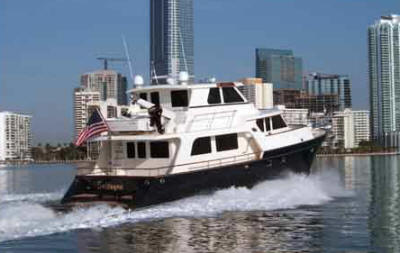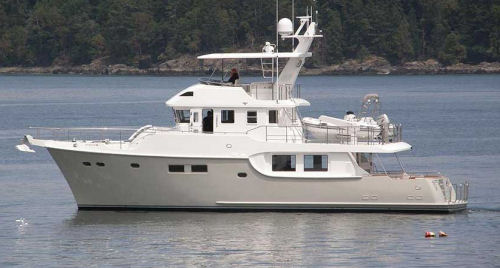5 Long Range Cruisers For Retiring Baby Boomers
2010 marks the 65th year since the end of World War II and that means that the first Baby Boomers are going to be hitting retirement age during the next 12 months – and for the next decade! Boomer yachtsmen in Europe and Asia will also start hitting their golden years and all have earned a well-deserved treat for a life well-lived. Now they can do something most of their fathers could only dream of doing – go long range cruising. Over the next few months we are going to feature a variety of sizes, types and brands for your consideration. This week we compare five motoryachts in the 55’ to 60’ range designed to take you anywhere in the world.
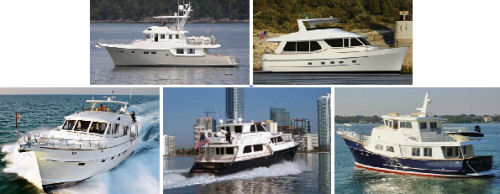
We compare the Nordhavn 60, Cheoy Lee 59, Grand Banks 59, Marlow 57E, and the Kadey-Krogen 55
More than a few people we know are clearing out their basements and attics, downsizing their house into something modest, selling off the third car, and buying a serious motoryacht for their sundown years. The unfortunate fact is that between age 65 and when one’s bones and muscles are ready for a pontoon is a relatively small window. When people hit that age they have to make a decision pretty quick if there is going to be a cruising boat in their future.
Nearly everyone, if they could afford it, would like to plop themselves in gin-clear water or in the shade of a palm-fringed island. So it comes down to the annual cost of living the dream. Can you afford it? The name of the game is to find out what you can budget for your annual operating expenses and act accordingly. Today we are looking at the 55’ to 60’ range.
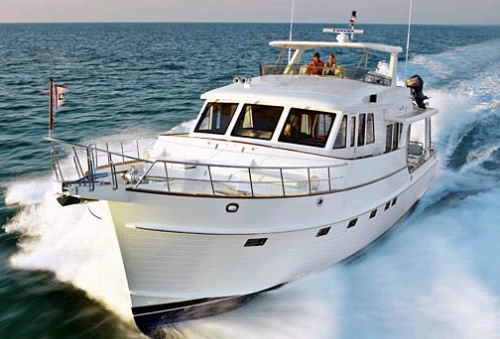
The Grand Banks Aleutian 59 looks good underway or at the dock. With twin 1000-hp diesels we’re told she’ll go over 25 knots WOT.
Depending on the size of one’s boat and many other factors, we reckon that a cruising couple can operate their 55’ to 60’ motoryacht for something between $50k and a $100k per year, depending on a lot of factors. The big fixed incremental costs of cruising are boat insurance, dockage and fuel, assuming the boat is paid for. So, if you can afford the operating expenses, the next question is which boat do you buy?
5 Serious Contenders Let’s look at five long range cruisers, all built by well-known first-rate builders, most of which have been in business a long time. The youngest is Marlow Yachts, which is a new-comer at 10 years old.
1. Kadey-Krogen 55
2. Marlow Yachts 57
3. Cheoy Lee Serenity 59
4. Grand Banks Aleutian 59
5. Nordhavn 60
All five of these boats are from 58' (17.84 m) to 63' (19.38 m) LOA, all have an 18’ (5.53 m) beam, except the Cheoy Lee Serenity 59 which has a 17’1” (5.26 m) beam. All draw about the same, going from 4’2” (1.28 m) for the Marlow, to 6’6” (2.0 m) for the Nordhavn. The other three draw 5’3”-4” (1.64 m). Only their displacements and engines are wildly divergent, but more about that later.
These boats range in cost from about $1.6 million to about $2.4 million. That is quite a spread, but as you will soon see there is a big difference in the boats, as well.
1. The MSRPs The current approximate (depending on options and engines installed) prices of the 5 boats are—
1. Marlow Yachts 57E $1,550,000
2. Cheoy Lee Serenity 59 $1,500,000 (E)
3. Kadey-Krogen 55 $1,850,000
4. Grand Banks Aleutian 59 $2,200,000
5. Nordhavn 60 $2,400,000
If these boats are all in the same class and about the same length and beam – and, in fact, all pretty much use the same components and equipment -- why do the prices vary so greatly? The first reason is because you are not buying a commodity. All boats in this size range are different and what has gone into them in terms of engineering, experience, marketing, warranty reserves, and tooling amortization is different. Also, the standard equipment varies greatly from boat to boat. While all five companies use the best equipment, some bake a lot of things in their base price and others do not. You’ll have to sit down with a yellow pad once you have narrowed your search down to a couple of boats.
All of these five brands are built in the Far East where labor costs are relatively low and skill levels relatively high. Overhead costs there are also low, and all things considered it is the most cost-efficient place to build these types of boats. All of these companies are under intense competitive pressures so their pricing is usually what they need to get. Our advice is hold off tossing a model out because of its price until you are down to the short strokes.
2. Depreciation Considerations Most boats depreciate. However, this class and size of motoryacht probably depreciates less than any class of boat on the market. The owners of Kadey-Krogen tell us that their boats generally do not depreciate much and that most of their owners have sold their boats for close to what they paid. In fact, the company states that they if any of their customers move up in size, they will take the trade crediting exactly what the owner paid.
This size range and type of motoryacht is in the “sweet spot.” And that spot is getting sweeter by the month as more and more baby boomers begin to think about getting into one of these boats before it is too late. Fifty-five to 70’ is about the smallest boat that is both comfortable to live on for prolonged periods of time for most people, and is also relatively comfortable offshore. It is also the smallest size big enough to have three guest cabins with two or three heads, although most cruising types find the third cabin rarely used, we’re told.
Because depreciation is less, you are able to enjoy this asset (unlike bonds, or land, or Krugerands) and at the end of your journey, if you have maintained the boat well, you should have a relatively small depreciation by boating standards. We would count on getting 60% to 70% of what we paid for the boat in 10 years, all things being “normal.” Some boats we have checked are selling for as high as 85% of what they sold for 10 years before in this class.
Which boat of the five will depreciate less? We don’t know, no one does. Factors such as the trend at the time ten years hence will probably be the biggest factor. Is the brand still in business? What is the condition of the engines? Can they be easily replaced? How does the gelcoat look? Is it a classic design?
3. Displacement is the Big Difference The most dramatic difference among these five boats – other than their exterior designs which are all quite different and each beautiful in their own distinctive way – is the displacement of the boats. Take a look—
1. Marlow Yachts 57E 61,000 lbs. 27,727 kgs.
2. Cheoy Lee Serenity 59 85,000 lbs. 38,636 kgs.
3. Grand Banks Aleutian 59 90,000 lbs. 40,909 kgs.
4. Kadey-Krogen 55 96,830 lbs. 44,013 kgs.
5. Nordhavn 60 120,000 lbs. 54,545 kgs.
Generally the heavier the boat the more expensive it is and certainly this holds true when comparing the Marlow Yachts 57E the lightest and the Nordhavn 60 the heaviest. Light boats can go fast and are easier to push than heavy ones. Heavier boats usually ride better in rough conditions. Clearly there is more material in the heavier boat, but make sure you know how much is lead. Decide if you want light displacement, or heavy displacement. In this case, if you want to go light, you go with the Marlow 57E, because the rest of the boats are heavy.
4. Cruising Speed The important thing about displacement is that that it will effect speed, fuel consumption, and ride. The heavier, deeper boats will be slower and cost more to propel at displacement speeds. Three of the boats – the Cheoy Lee, Kadey-Krogen and Nordhavn -- are designed to travel only at displacement speeds, which in the case of these three boats is about 7 to 8 knots.
The Marlow and the Aleutian are semi-displacement boats. Eventhough the Aleutian is heavy, by putting big engines in it, because of its bottom shape it can plane. It is the only boat of the five in this category, both heavy and able to plane.
Lets look at their stated speeds (we have not tested any of these five boats)—
1. Marlow Yachts 57E 18 knots Max with 2x Cat C-9 -575hp engines.
2. Grand Banks Aleutian 59 25+ knots with 2x Cat C-18 1015-hp engines.
3. Kadey-Krogen 55 8 knots with 2x John Deere 158-hp engines.
4. Cheoy Lee Serenity 59 8 knots with 1 John Deere 330-hp engine
5. Nordhavn 60 7-8 knots with 1 John Deere 330-hp engine
Cruising speeds are less for the two hot shots above than the numbers state, because they are speed at WOT. The Marlow will cruise at 15 knots, and the Aleutian will be comfortable around 18-20 knots depending on the engines. Because the Nordhavn 60 weighs the most and draws the most – 6’6” (2 m) – it is the hardest of the five boats to push so cannot come close to the fuel efficiency of the Cheoy Lee 59 with an identical single engine. On the other hand, it has characteristics that the Cheoy Lee 59 does not have, such as a flying bridge on top of its pilothouse and crew cabin, and it will certainly ride differently.
Because the Marlow 57E is so light, it will always be able to go faster and burn less fuel than the Grand Banks Aleutian 59 with comparable engines. Of course, both the Marlow and the Aleutian have the ability to travel at 8 knots like the other three boats, and burn far less fuel than they would at their semi-displacement speeds. This is major and critical difference among the five boats and puts them in two distinctly different categories.
Buyers who like the cruising lifestyle but can’t stand to go only 8 knots, or who want to have the ability to run fast now and then, immediately see their options drop to two; the Marlow or Aleutian. (These buyers should also look at flush deck semi-displacement motoryachts to once again increase their options, but then other things will change, such as depreciation, which may be greater.)
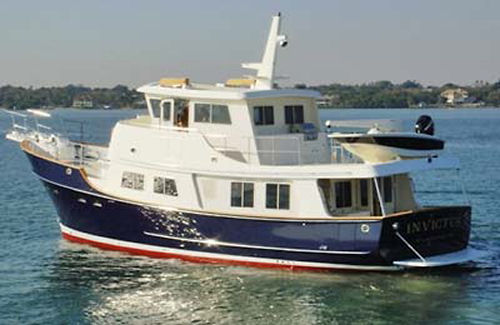
The Kadey-Krogen 55 has good all-around characteristics for a displacement vessel, and is in the middle of three displacement vessels here in terms of weight.
5. How Many Staterooms & Heads? Truth be told, most retired cruising couples travel by themselves. There are several reasons for this, one of which is that friends are still working and can’t take two months off. Other friends get sea sick or are just not into the boating lifestyle. (Hard to believe, but some people just don’t like the water.) Then there is the part about living with another couple for more than a week in a small space and what it has in common with dead fish.
For all these reasons and more, three of the five boats in this survey have only two staterooms and two heads. The option of crew quarters, we think, is an important one. Not because we think owners should have captains running the boat for them – on the contrary, to us, owner/operator is the only way to go – but rather because it is nice to be able to take on a young hand to help with the chores.
We must admit to preferring to have someone else wash down the boat after a the day’s run, to say nothing of cleaning up messes in the bilge. And Mom gets pretty cranky these days about dragging fenders around. So to us, crew’s quarters means a mate aboard to schlep fenders, wash down the boat and varnish the teak trim. Lets take a look—
1. Grand Banks Aleutian 59 3 staterooms 3 heads 1 crew cabin
2. Marlow Yachts 57E 3 staterooms 2 heads 0 crew cabin
3. Nordhavn 60 2 staterooms 2 head no crew cabin
4. Kadey-Krogen 55 2 staterooms 2 heads no crew cabin
4. Cheoy Lee Serenity 59 2 staterooms 2 heads no crew cabin
Please keep in mind that all of these boats are built one at a time. If you want three cabins instead of two, you can usually get, and the other way around as well. If the builder will not accommodate you, move on down the road.
Finally, let's address the subject of engines, generators and mechanical equipment. It is here where there is a lot of cost and the MSRPs of the boats are divergent because these lists of equipment are quite different from boat to boat. A couple of the boats come rather well equipped, and a couple will need some equipment added. This will tend to even-up the prices a bit, since most builders use the same equipment suppliers.
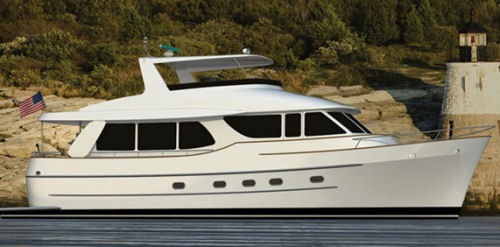
The Cheoy Lee Serenity 59 is one the builder’s newest boats and is the smallest of yacht in the Serenity line of displacement cruising motoryachts.
6. Power for the Vessel On the subject of main propulsion there is again a fork in the road that consumers must consider. Three of the five boats have twin-engine installations. Of the two that have single engines, the Nordhavn is 41% heavier than the Cheoy Lee Serenity. Both of the single-engine-driven vessels have backup get-home systems. At first blush, the redundancy seems important, and for that reason there has always been a lot resistance to single engine displacement boats, despite the fact threat they are incredibly fuel efficient (and that is all most ocean-going freighters and tankers have). As a result, even Kadey-Krogen and Nordhavn are installing twins these days but they both started out with single engines.
The whole subject of redundant power can fill a complete newsletter, so we will save that complicated discussion for another time, and simply say that there are strong arguments on both sides. In any case, diesel engines are not what cause problems cruising – it is contaminated diesel fuel. Here’s a look at their power—
1. Marlow Yachts 57E 2x Caterpillar C-9 575-hp
2. Grand Banks Aleutian 59 2x Caterpillar C-9 500-hp
3. Kadey-Krogen 55 2x John Deere 158-hp
4. Nordhavn 60 1x John Deere 330-hp + Lugger Wing engine
5. Cheoy Lee 59 1x John Deere 330-hp + Get Home System
Both Nordhavn and Cheoy Lee will install twins if you prefer. If you want a single engine in the others, you'll have to ask.
7. Factory Support Finally, what sort of factory support will you get? We’d like to be able to put the answer into a list like the other aspects of the models but that is not possible. It is however, an important consideration. All of the companies above will gladly fix your punch list of items that you have after you have used the boat a month or so and have uncovered a bunch of little things that always seem to pop up no matter who builds the boat. They may even do it after one year, but you need to have in writing exactly what they will do.
Anyone buying a boat of this size from any builder must be prepared for things going wrong. Boats are not like cars. We have heard good things about some of the companies above and we have heard discouraging things about a couple of others when it comes to aftermarket support. Our suggestion is that once you have decided on which boat you want to buy, all of these dealers sell factory-direct through company-owned sales offices, except Grand Banks. (See BoatTEST.com article on scoping out brand management and culture…)
Now it is time to make your decision. Don’t dither because there are very few of these boats in inventory, if any at all. You will have to order what you want in almost all cases, and by the time all of the dust settles you can count on the process taking 9 months for this size boat – if there is no backlog. Prices are going up, and you aren’t getting any younger. Our advice is, if you can afford it, there will never be a better time to buy than now.
The BoatTEST.com staff will be glad to consult, pro bono, with members preparing to buy a new motoryacht in this class. Simply write us at: [email protected].
